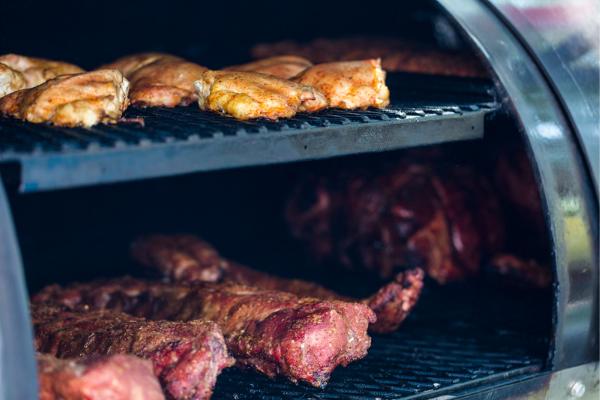If the worlds of culinary creation and firewood are to collide, you’ll need to settle for nothing less than premium cooking wood. But what is premium cooking wood, and what distinguishes it from plain, old firewood? We hope this article helps you remember a couple important nuggets about finding the best cooking wood no matter what meat you’d like to smoke.
The Best Types of Wood
While the best cooking wood depends on the meat, all effective species are kiln-dried hardwoods. Because of their density, hardwoods yield the brightest flames for the most time. Putting hardwoods in a kiln improves them further by drying them in a way that seasoning can’t. Not only does the driest wood mitigate smoke, but it’s also easier to burn.
Mind Your Clearance
When you build a fire outside or in a fireplace, log size isn’t much of an issue. If the firepit needs to be bigger, you can make it bigger. If you need to lay down extra tinder or kindling, pick up some more sticks. When you buy cooking wood, you’ll need to fit it into a device, whether you have a grill, pizza oven, or titular smoker. If you make a mistake with your order, cutting the wood yourself will be the only way to avoid wasting the money you’ve spent.
The Right Size
Only the biggest smokers and grills can fit genuine logs. Unless you’re buying wood for your restaurant, chunks and chips will suit your needs better. For example, because pizza ovens are so thin, most of them require chips.
For grilling as well as smoking, chunks will be best because they can help you control temperature minutely enough to maintain it. About four inches in diameter, each of these chunks is about as big as a grapefruit. Certainly, chunks are larger than chips, but they should be able to fit comfortably in most smokers or grills. The bottom line is that regular firewood is too big.
The Right Amount
How many chunks or chips of wood do you need? This depends on how often you plan to cook. For a single cookout, a bundle with no more than seven pieces of wood will be the best place to start. Smoking meat all summer long might require an entire cord of wood, but smoking meat every other weekend will require either a face cord or a smaller denomination, which most vendors like Lumberjacks are happy to provide.
Once you’re ready to store your wood, be sure to stack it in a way that keeps it dry. Leave lots of space among the pieces to prioritize airflow. If you’re storing your wood outside, a tarp is a great way to shield it from the elements.

A quality smoker is perfect for a whole summer of smoking and beyond.
The Right Company
Cutting corners is a common problem among firewood vendors, especially with regard to cooking wood. Not only do you need kiln-dried hardwood, but you also have to make sure that you’re getting the right size. Asking companies point-blank about how they prepare their firewood and looking at reviews online are the most effective ways to investigate.
Choosing the Right Smoking Wood
In comparison to grilling, barbecuing and making pizza, smoking meat is more involved. A slow, indirect process, smoking requires lots of time and painstaking precision to achieve a perfectly smoky flavor. To this end, oak has two traits that’re great for newcomers. As the densest hardwood, oak can help you sustain temperature for many hours. Furthermore, oak’s flavor is too mild to overpower anything. If you want to learn how to smoke meat, oak can teach you.
Smoking Wood for Red Meats
For your first cookout, red meat won’t be as unwieldy as white meat that likes to burn. Here are a few popular options, each of which is complemented by a particular species of wood. If you’re ready to move on from oak, other suggestions are as follows.
Best Wood for Smoking Brisket
A dense, tough cut of meat, brisket needs dense, tough wood. Oak works well, but so does hickory, whose potent flavor makes it the hardest to use. Both options provide steady heat and strong smoke that penetrates deeply into the meat.
Best Wood for Smoking Pork
Again, oak and hickory are best. While you may not have something as thick as pork shoulder, pork is dense no matter how much of it you plan to cook, requiring a steady burn and smoke that cooks the densest meats all the way through.
Best Wood for Smoking Ribs
Pork ribs can also handle a heavy concentration of smoke, including that of hickory. While the earthy, bacon-esque flavor of hickory complements ribs’ flavor best, oak is a close second, providing a similarly powerful combination of heat and smoke.

Though difficult, smoking is a versatile practice that makes some savory dishes.
Smoking Wood for White Meats
Now that you’ve tackled red meat, you’re ready for the big leagues. White meat might like to dry up and burn, but we believe in you! With the right cooking wood, you can smoke fish and poultry to perfection.
Best Wood for Smoking Chicken
Generally, fruitwoods are better for poultry, as they tend to yield cooler fires and less smoke. If you’re looking for that signature smoky flavor, apple wood is best. If you’re looking for more of a sweet, barbecue flavor, you can try hickory.
Best Wood for Smoking Turkey
If you’ve ever attended a Thanksgiving dinner, you know that turkey loves to dry up and burn more than any other bird on the planet. This is a job for cherry wood. Like apple wood, cherry wood provides an immaculately smoky flavor, but its subtle fruitiness adds a little tang and color to this dry bird.
Best Wood for Smoking Salmon
As hickory is the most difficult wood to work with, fish is the most difficult meat to smoke. More delicate than poultry, salmon also requires the mild touch of fruitwoods. Apple and peach wood are both excellent for smoking salmon.
An Initial Medley
With any luck, this article has shown you how to smoke your first meat. There are many options to start with, but using oak to smoke red meat should probably be your next move. If anything on this list piques your interest in upping your culinary game, feel free to contact us. We’re only a phone call away at 815-337-1451.We also deliver our premium firewood throughout Chicagoland including cities like Schaumburg and many more!








